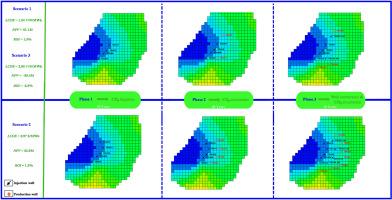Unlocking the potentials of depleted gas fields: A numerical evaluation of underground CO2 storage and geothermal energy harvesting
IF 3.6
引用次数: 0
Abstract
Using partial underground CO2 storage as a working agent to harvest geothermal energy is a promising carbon capture, utilization, and storage (CCUS) method. It is particularly economically feasible to use or retrofit the existing infrastructure of a hydrocarbon field. Although technical advantages of integrated CO2 sequestration and CO2-circulated geothermal harvest using depleted hydrocarbon reservoirs have been reported, quantitative evaluations of economic benefits using existing wells of realistic reservoirs are rare. In this study, a 3-D hydrothermal flow model is built for the Triassic Argilo-Gréseux Supérieur (TAGS) Formation of the Toual gas field, Algeria using Schlumberger Petrel and CMG-STARS software. A three-phase operational scheme is proposed for sequential CO2 sequestration and CO2-circulated geothermal extraction over 100 years. The first phase is injecting CO2 for 30 years, followed by concurrent cold CO2 injection and hot CO2 extraction in the developed CO2 plume (circulation) for 40 years as the second phase. In the third phase, producing wells in the second phase are converted to injection wells while outer wells start to extract hot CO2 for another 30 years. Scenario 1 is simulated using the selected nine existing wells of the field, while an optimized Scenario 2 is designed and simulated by adding seven newly drilled wells in addition to the existing wells. Scenario 3 shares the same numerical simulation of Scenario 1, but assumes the selected nine existing wells are newly drilled for the economic evaluation. Levelized Cost of Energy (LCOE), Net Present Value (NPV), and Return on Investment (ROI) are used as economic indicators. The results demonstrate that Scenario 2, which combines the use of existing and newly drilled wells, yields improved economic metrics compared to Scenario 1: 0.97 USD/MWh vs. 1.54 USD/MWh for LCOE and $2.9M vs. $1.1M for NPV. Both scenarios represent profitable endeavors, with ROI values of 1.3 % and 1.5 %, respectively. In contrast, Scenario 3 represents the worst-case scenario, with the highest LCOE at 2.90 USD/MWh and the lowest NPV and ROI at -$0.4M and -0.2 %, respectively. The negative NPV and ROI in Scenario 3 indicates that CO2-circulated geothermal harvesting in aquifers or giant depleted hydrocarbon fields, without leveraging existing infrastructure, is economically infeasible.

释放枯竭天然气田的潜力:地下二氧化碳储存和地热能收集的数值评估
利用部分地下CO2储存作为工作剂来获取地热能是一种很有前途的碳捕获、利用和储存(CCUS)方法。利用或改造现有油气田的基础设施在经济上尤其可行。尽管已经报道了利用枯竭油气藏进行CO2封存和CO2循环地热采收的技术优势,但利用实际油藏的现有井对经济效益进行定量评价的情况很少。利用斯伦贝谢Petrel软件和CMG-STARS软件,建立了阿尔及利亚Toual气田三叠系argilo - grsamseux supsamrieur (TAGS)组的三维热液流动模型。提出了一种为期100年的连续CO2封存和循环CO2地热提取的三阶段运行方案。第一阶段为注入CO2 30年,第二阶段为在已开发的CO2羽流(循环)中同时注入冷CO2和热CO2萃取40年。在第三阶段,第二阶段的生产井转换为注水井,而外部井开始提取热二氧化碳,再持续30年。场景1使用选定的油田现有的9口井进行模拟,而场景2则通过在现有井的基础上增加7口新钻的井进行优化设计和模拟。场景3与场景1具有相同的数值模拟,但假设所选的9口现有井是新钻的,以进行经济评估。能源平准化成本(LCOE)、净现值(NPV)和投资回报率(ROI)作为经济指标。结果表明,与方案1相比,方案2(结合使用现有井和新钻井)的经济指标有所改善:LCOE为0.97美元/兆瓦时,而LCOE为1.54美元/兆瓦时,NPV为290万美元,而NPV为110万美元。这两种情况都表示有利可图的努力,ROI值分别为1.3%和1.5%。相比之下,方案3代表了最坏的情况,最高的LCOE为2.90美元/兆瓦时,最低的NPV和ROI分别为- 40万美元和- 0.2%。情景3的负NPV和负ROI表明,如果不利用现有基础设施,在含水层或大型枯竭碳氢气田进行二氧化碳循环地热采收在经济上是不可行的。
本文章由计算机程序翻译,如有差异,请以英文原文为准。
求助全文
约1分钟内获得全文
求助全文

 求助内容:
求助内容: 应助结果提醒方式:
应助结果提醒方式:


